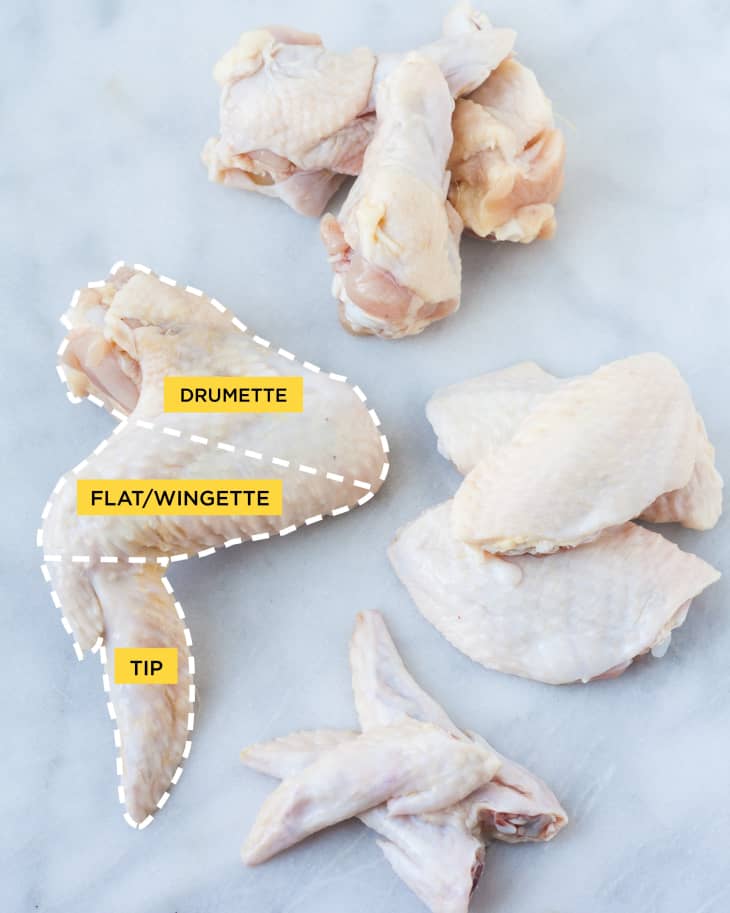An Anatomical Guide to Chicken Wings
My favorite part of a chicken is, hands down, the wing. Whether I’m nibbling on one as I carve up a whole roasted chicken, or feasting on a messy pile of saucy buffalo wings, they’re fun to eat and oh-so-satisfying to a dark-meat lover like me. If you look closely, whole chicken wings are actually composed of three parts. Do you know what they are called?
Whole Intact Wings vs Cut and Sectioned Off
I consider chicken wings a bit of a delicacy since there are only two per chicken, but they pack a ton of flavor. While they’re available at pretty much any grocery store, they’re usually sold already butchered into smaller pieces. Those looking for whole, intact wings might have to go to a butcher shop or ask for a special order, although I’ve had luck at Whole Foods.
Why are they sold cut and sectioned off nowadays? It might be because they’re easier to cook evenly and eat when they’re cut up, or it might be because some people prefer some parts of the wings over others and want to choose. In my household, I prefer the flats of the wings, while my husband likes the drumettes. This means we never fight over the same pieces — must be why I married the guy!
Here are the three parts of the chicken wing:
Drumettes
Let’s start at the portion of the wing that’s attached to the main part of the chicken. This is called the drumette, probably due to the fact that it’s shaped like the larger chicken drumstick. There’s one main piece of bone in the middle, but there are some joints and cartilage on both ends.
Drumettes are irregular in shape: one end is rounded and meaty, and then it tapers down as it gets to the middle part of the wing. The meat on drumettes, while still technically dark meat, does have a texture a bit closer to white meat, and there’s a fairly high ratio of meat to skin.
Wingettes/Flats
The middle part of the wing is called the wingette, or flat. I like calling it flat because that’s exactly what the shape is. There are two thin bones that run parallel to each other down the length of the flat, and it has tender dark meat and is completely covered with skin.
Tips
Last comes the wing tips — those tiny, pointy pieces, shaped like a feather at the end. They’re almost completely skin, bone, and cartilage, with pretty much no meat, although some people love nibbling on the chicken wing tips since they love eating chicken skin. Chicken wings sold with wing tips still attached are harder to come by nowadays, as I’m guessing consumers don’t really have as much use for them.
Cooking Chicken Wings
Even if you manage to find whole chicken wings, most recipes call for breaking them down into the three pieces first. Why do this extra step?
A whole wing isn’t even in shape or thickness, and doesn’t sit flat on a surface. Cutting it up, however, means that each piece sits more easily on whatever grill or pan you’re cooking it in. More of the surface area can brown, and they’re easier to flip and move around for even cooking. It also means that people can eat only their favorite parts if they so choose (flats forever!).
Chicken wings can be cooked pretty much any way you’d normally cook chicken: broiled, seared, grilled, fried, or even roasted. Due to their higher proportions of skin and bones, they also make delicious chicken stock with lots of flavor and body.
If you don’t like to eat wing tips, save them for your next batch of stock or simmer them directly in the sauce or glaze you’re making for the wings — they’ll add some nice bonus chicken flavor.
